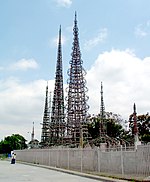Willowbrook/Rosa Parks station

Willowbrook/Rosa Parks station (formerly Imperial/Wilmington/Rosa Parks station) is a major transport hub and Los Angeles Metro Rail station that serves the A Line and C Line. The station, located at the intersection of Imperial Highway and Wilmington Avenue in the Willowbrook community of Los Angeles County, is a major transfer point for commuters.As a major transfer station, Willowbrook/Rosa Parks Station also acts as a major bus hub, serving many bus routes operated by Metro and other regional/municipal transit agencies. The station also has park and ride facilities, including 975 parking spaces and 4 bike lockers. To the east of the station is the Metro Rail Operations Center, which is the dispatch hub for all Metro Rail train operators. The station is located in unincorporated Willowbrook, near the Los Angeles community of Watts in the South Los Angeles region. It is directly across the street from the Imperial Courts Housing Project, which is located within the City of Los Angeles. The C Line platform for this station is located in the middle of the I-105 Freeway. The station's official name memorializes Rosa Parks, an African-American civil rights activist. From the Blue (A) Line's opening on July 14, 1990 until the Green (C) Line opened on August 12, 1995 the Blue Line station platform was known as Imperial station while the Green Line station platform was planned to be called Wilmington station and then the station was called Imperial/Wilmington station from the Green Line's opening in 1995 until it was changed to its current name in 2011.
Excerpt from the Wikipedia article Willowbrook/Rosa Parks station (License: CC BY-SA 3.0, Authors, Images).Willowbrook/Rosa Parks station
Century Freeway,
Geographical coordinates (GPS) Address Nearby Places Show on map
Geographical coordinates (GPS)
| Latitude | Longitude |
|---|---|
| N 33.9282 ° | E -118.238 ° |
Address
Willowbrook/Rosa Parks Station
Century Freeway
90059 , Willowbrook
California, United States
Open on Google Maps






